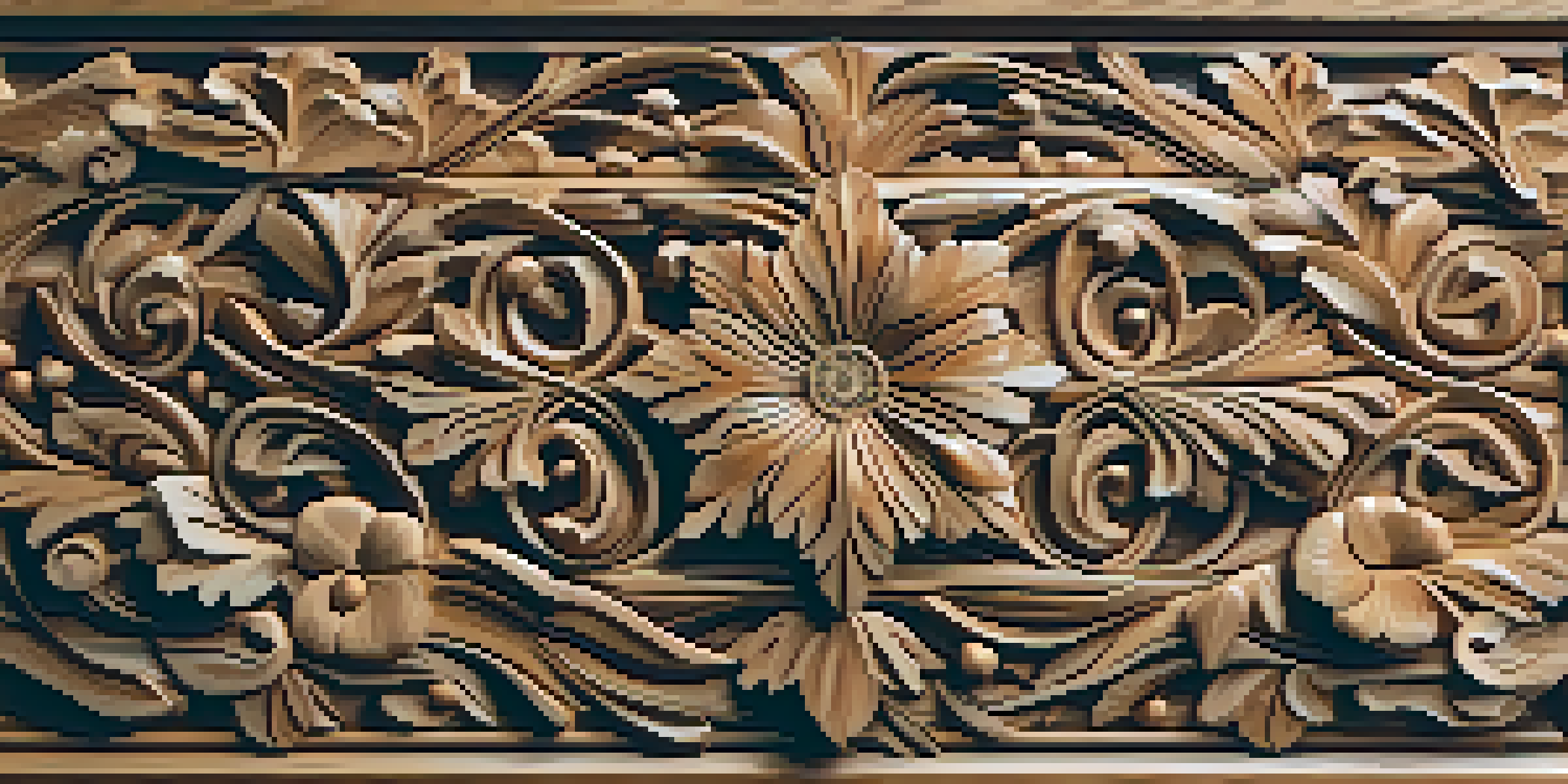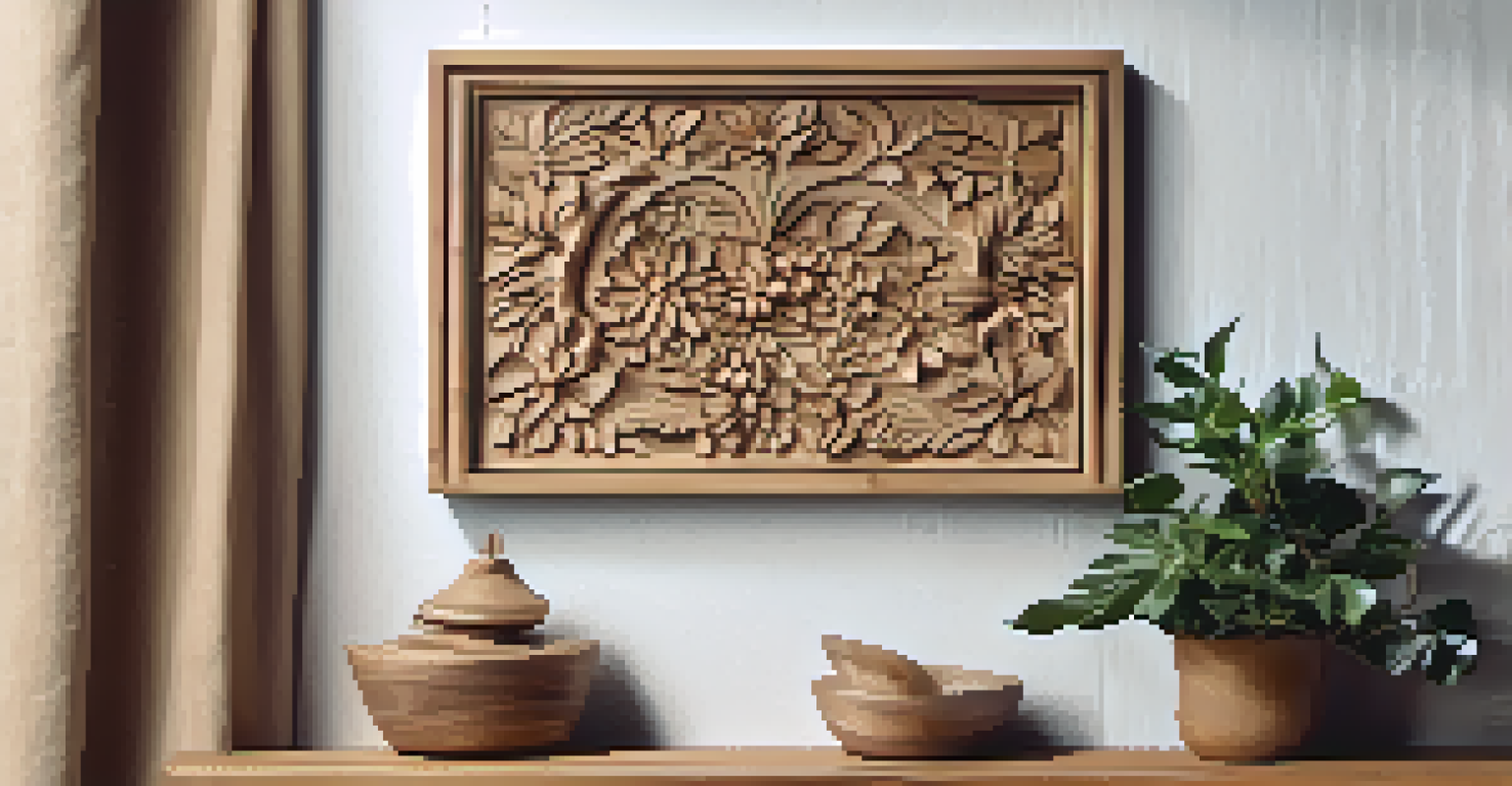Exploring Relief Carving for Stunning Home Displays

What is Relief Carving and Its Origins?
Relief carving is a sculptural technique where figures are carved into a flat surface, creating a stunning three-dimensional effect. This art form has roots that trace back to ancient civilizations, where it adorned temples and monuments, telling stories through intricate designs. The beauty of relief carving lies in its ability to transform ordinary surfaces into captivating displays of artistry.
Every artist was first an amateur.
Imagine walking through a museum and being drawn to a beautifully carved wooden panel that seems to tell a story. That’s the magic of relief carving—where the flat surface becomes a canvas for creativity. Artists use various tools to chisel away material, creating depth and dimension that can transport viewers to another time and place.
Today, relief carving is not just for museums; it's also a fantastic way to personalize your home. Whether you opt for a classic design or a modern twist, relief carvings can add a unique touch to your decor, making your space feel truly special.
Tools and Materials for Beginners
Getting started with relief carving doesn’t have to be intimidating. The essential tools you’ll need include carving knives, chisels, and a mallet, which can be found at most craft stores. Additionally, selecting the right material is crucial; basswood and butternut are popular choices for beginners due to their softness and ease of carving.

Think of your carving tools as your paintbrushes. Just as an artist selects the perfect brush for their canvas, a relief carver chooses tools that will help bring their vision to life. Each tool has its own purpose, whether it’s for detailed work or broader strokes, allowing for a range of creative expression.
Understanding Relief Carving
Relief carving is a sculptural technique that transforms flat surfaces into three-dimensional artworks, with origins in ancient civilizations.
Don’t forget to invest in safety gear as well! A carving glove and goggles can protect your hands and eyes, ensuring a safe and enjoyable carving experience as you explore this captivating craft.
Choosing Your First Relief Carving Project
When selecting your first relief carving project, it’s best to start with something simple. Consider carving a small decorative item like a coaster or a wall plaque featuring a basic design. This approach allows you to build your skills without feeling overwhelmed by complexity.
The only way to do great work is to love what you do.
Picture yourself creating a beautiful floral pattern that can serve as a centerpiece in your living room. Beginning with a straightforward design allows you to focus on mastering the techniques, such as controlling your tools and understanding how different cuts affect the final appearance.
As you gain confidence, you can gradually tackle more intricate designs. The key is to enjoy the process, allowing your creativity to flourish as each successful project adds to your home’s charm.
Techniques to Master in Relief Carving
Once you’ve settled into your relief carving journey, it’s time to focus on mastering essential techniques. Start with basic cuts, such as stopping cuts and veining, which will help you create depth and detail in your designs. Practicing these techniques will significantly enhance your overall skill set.
Think of carving like cooking; mastering basic techniques is essential before you can create gourmet dishes. Similarly, knowing how to execute clean cuts and control your chisel will set the foundation for more advanced projects. Each technique you learn builds on the last, allowing you to tackle complex designs with confidence.
Essential Tools for Beginners
Beginners should start with basic tools like carving knives and chisels, along with soft woods like basswood for easier carving.
Don’t hesitate to explore online tutorials or local workshops—learning from experienced carvers can provide invaluable insights into refining your skills. Remember, practice makes perfect, and each carving session brings you one step closer to becoming a proficient relief carver.
Incorporating Relief Carvings into Home Decor
Once you’ve created a few relief carvings, it’s time to showcase your work in your home. These pieces can serve as stunning focal points, whether displayed on a mantel, hung on a wall, or used as unique table centerpieces. The beauty of relief carving is that it complements various decor styles, from rustic to modern.
Imagine a beautifully carved wooden panel that captures the essence of nature, hanging above your fireplace. Such a piece not only adds character but also serves as a conversation starter for guests. By incorporating your creations into your decor, you can express your personal style and creativity.
Consider mixing and matching your relief carvings with other decor elements, such as plants or textiles, to create a harmonious and inviting atmosphere. This blending of materials can elevate your space, making it feel cozy and uniquely yours.
Caring for Your Relief Carvings
Once you've crafted your relief carvings, it's essential to care for them to ensure they remain beautiful for years to come. Regular dusting with a soft cloth can help maintain their appearance, while occasional polishing with wood oil can enhance the wood's natural beauty and protect it from drying out.
Think of your carvings as cherished keepsakes that deserve special treatment. Just like a favorite piece of clothing or a beloved book, regular maintenance will keep them looking their best. Avoid placing your carvings in direct sunlight, as prolonged exposure can cause fading and damage over time.
Showcasing Your Creations
Incorporating relief carvings into home decor can enhance your space, serving as unique focal points that reflect personal style.
If your carving gets damaged, don’t despair! Minor repairs can often be made with wood glue or filler. Taking the time to care for your relief carvings not only preserves their beauty but also ensures they remain a valued part of your home decor.
Getting Inspired: Resources and Communities
As you delve into the world of relief carving, inspiration can be found everywhere. Books, online tutorials, and social media platforms like Pinterest and Instagram are fantastic resources to discover new ideas and techniques. Joining online forums or local carving clubs can also connect you with fellow enthusiasts who share your passion.
Imagine being part of a community that celebrates creativity and craftsmanship. Engaging with other carvers can provide motivation, support, and valuable feedback on your work. Sharing your progress and learning from others can make the journey even more enjoyable.

Don’t hesitate to seek inspiration from nature, architecture, or historical designs—these can serve as a launching pad for your own unique creations. Remember, every carving tells a story, and the more you explore, the richer your narrative will become.